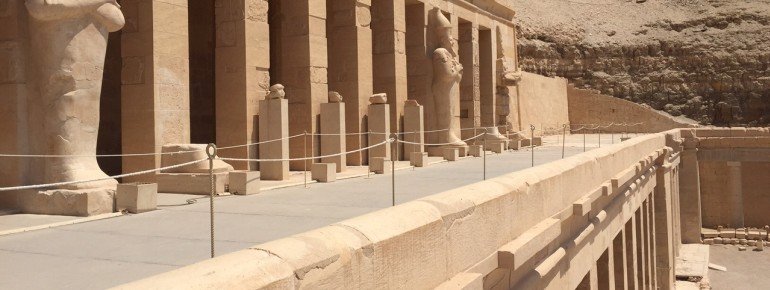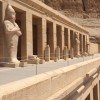Contents
Description
The Only Terrace Temple in Egypt
The mortuary temple of the ancient Egyptian queen Hatshepsut is the best-preserved temple complex in Thebes West, in present-day Luxor. It is also the only surviving terrace temple in all of Egypt. Constructed during the 18th Dynasty of the so-called New Kingdom, around 1550 BC, the temple is made entirely of limestone and is notable for its unique architecture: it consists of three terraces formed by open colonnades. The temple remained in use until the Ptolemaic period. Later, the Coptic Monastery of Phoibammon was established on its ruins and operated by various bishops until the 11th century AD.
The Temple’s Unique Architecture
A roughly one-kilometer-long processional road leads eastward from the temple complex. This once extended all the way to the Temple of Amun in Karnak and was lined with sphinxes on both sides.
Typically, Egyptian temples consist of a first pylon, a courtyard, a second pylon, another courtyard, and a hypostyle hall. In the mortuary temple of Hatshepsut, however, these traditional pylons are replaced by colonnades. The courtyards rise upward in a terraced layout and are connected by ramps.
Ancient Egyptian Chapels Within the Temple
The temple also contains several chapels dedicated to ancient Egyptian deities: one is devoted to Hathor and features typical depictions of the goddess as a cow. Two additional chapels were built for the god Anubis. The sun sanctuary, accessible from the third terrace via a staircase, shows the sun’s night journey from sunset to sunrise depicted on the walls. Hatshepsut’s own chapel is one of the largest within the temple complex and was once richly decorated. Unfortunately, very few of the wall paintings remain today. The most important chapel in the mortuary temple is dedicated to Amun-Re, the chief of the ancient Egyptian gods and the local god of Thebes. It is accessed through a large granite gate. Inside are two statues of Queen Hatshepsut and wall reliefs of Amun-Re.
Historical Information
Construction of the Temple Complex
The temple was built over a period of about 15 years during the reign of Queen Hatshepsut. Various hidden inscriptions and an unfinished tomb beneath the first terrace suggest that the architect of the complex was likely Steward Senenmut.
Scholarly Research on the Mortuary Temple
French Egyptologist Auguste Mariette conducted the first surveys of the temple in the 19th century, although he did not document them. Around the turn of the 20th century, Édouard Naville of the British Egypt Exploration Fund cleared fallen rocks and the Coptic monastery in order to access the parts of the temple buried under debris. The Metropolitan Museum of Art and the Egyptian Antiquities Service later conducted further excavations. Since 1961, reconstruction and restoration work has been ongoing, led by the Polish Center of Mediterranean Archaeology at the University of Warsaw in cooperation with Egypt’s Supreme Council of Antiquities.
The Attack of November 17, 1997
On November 17, 1997, the mortuary temple was the site of the deadliest terrorist attack on tourists in Egyptian history. Known as the “Luxor Massacre,” the attack was carried out by members of the Islamist group Gama'a al-Islamiyya. Sixty-two people lost their lives. As a result, Egypt’s tourism industry suffered a severe decline for years. Today, tourism police officers provide security for visitors at historical sites and public spaces throughout the country.
How to get there
As a tourist, you should visit the Mortuary Temple of Hatshepsut and the other sights of Thebes West accompanied by an experienced tour guide. Typically, you will be brought there comfortably by coach, either from a Nile cruise ship or from one of the Red Sea resorts. Visiting on your own is not recommended, as you would miss out on important historical background information and it is generally unwise to navigate Luxor’s chaotic traffic alone. However, if you still prefer to travel independently, you can take a taxi.




